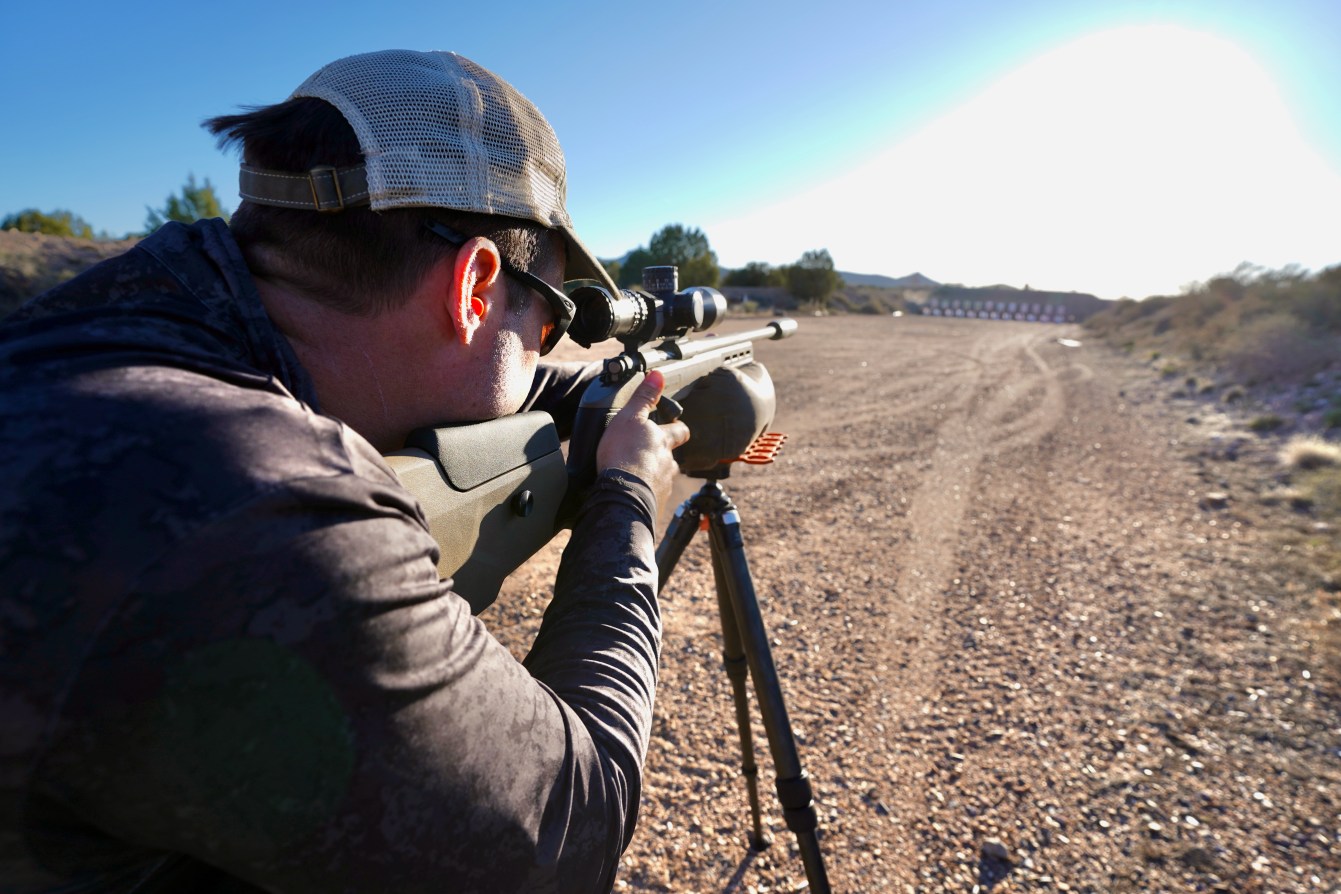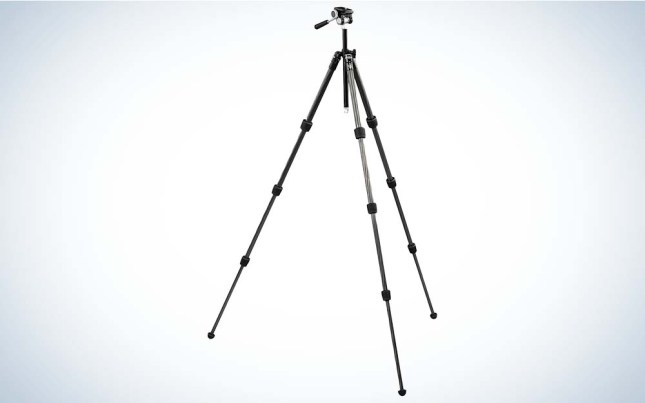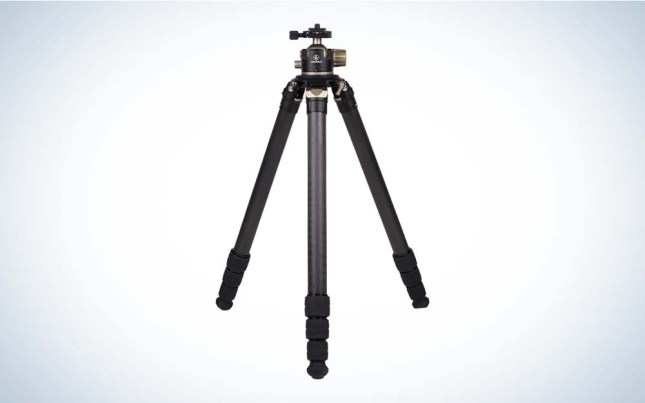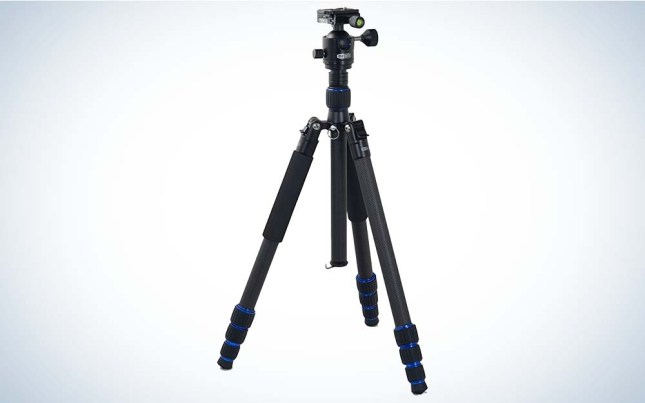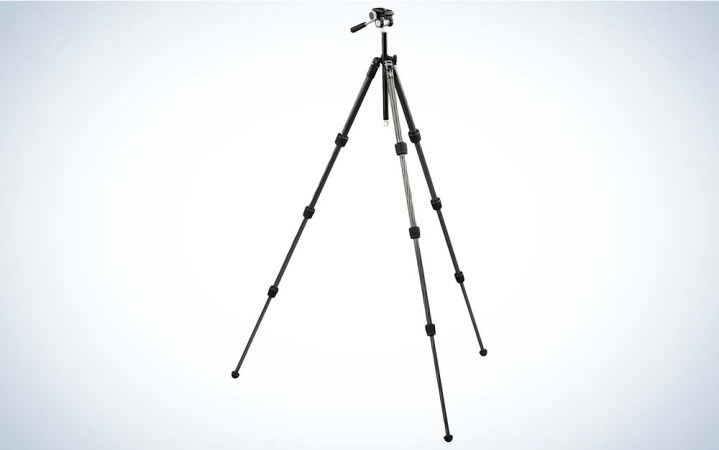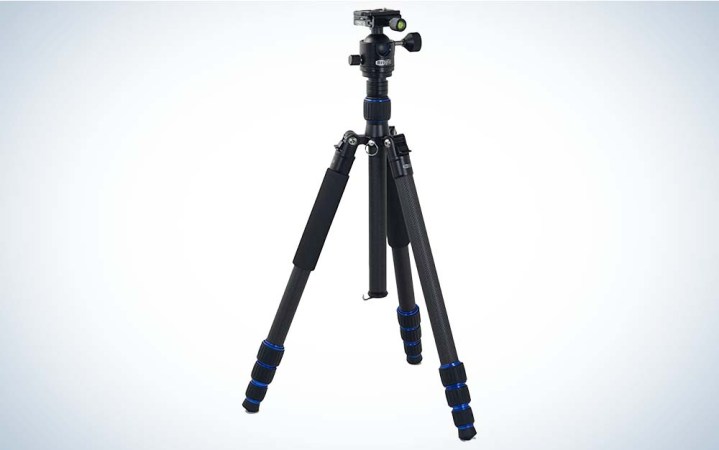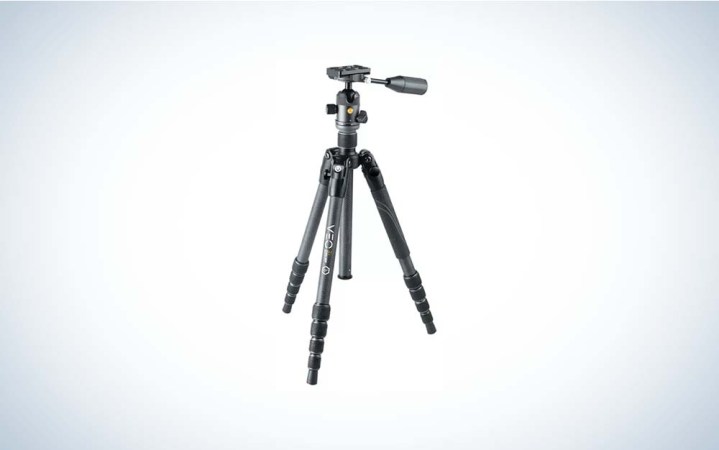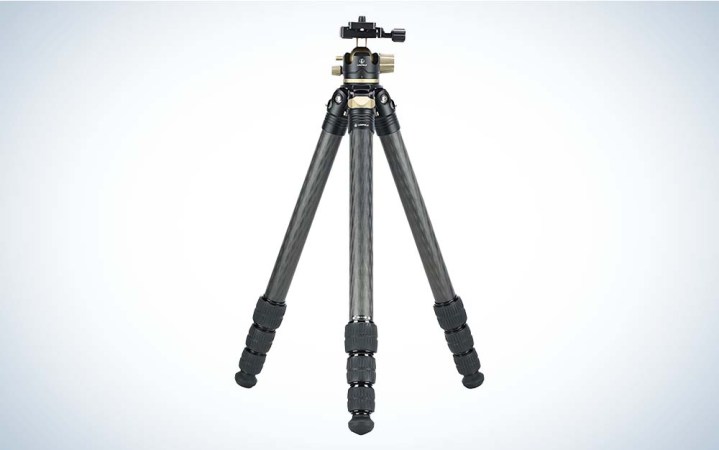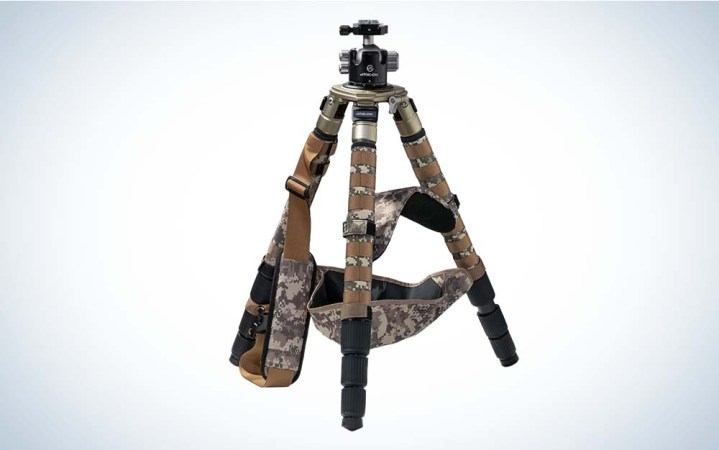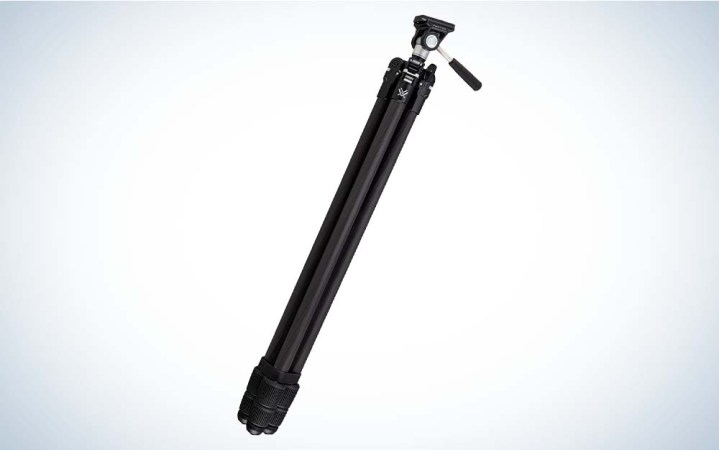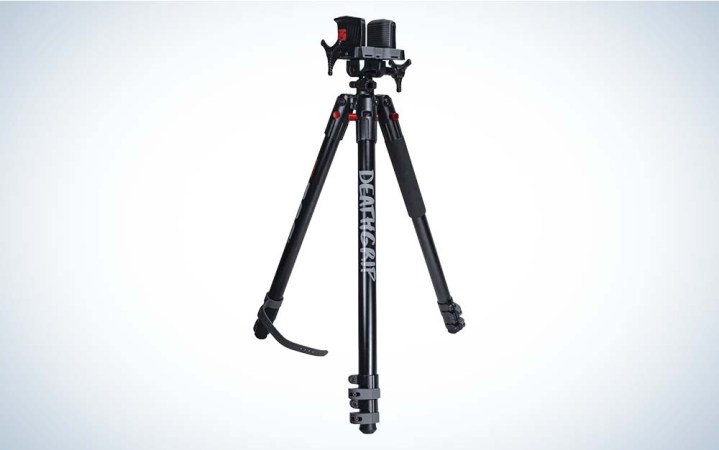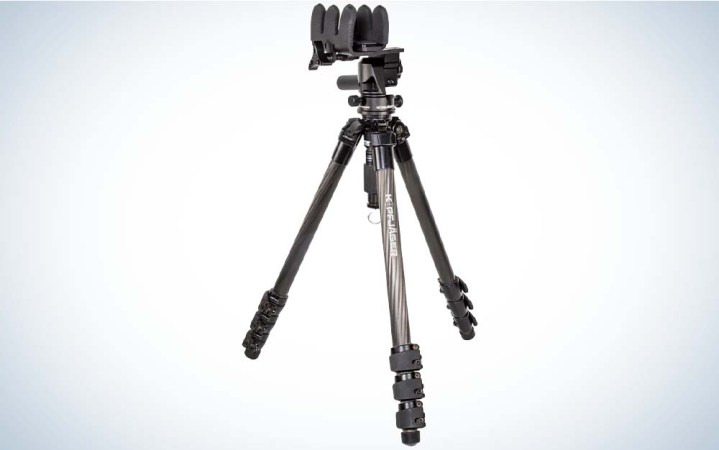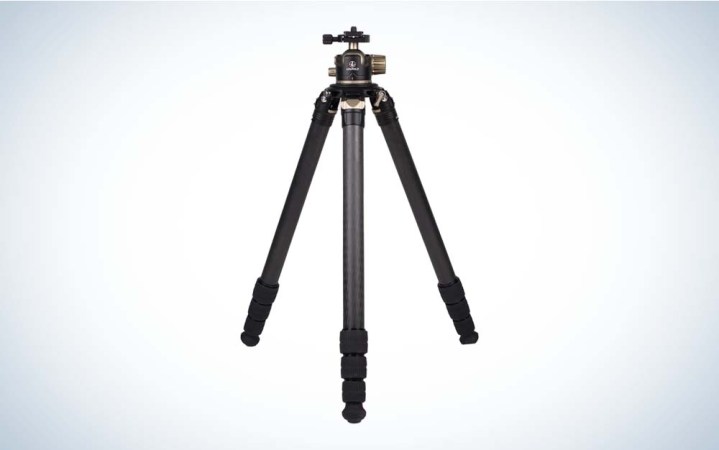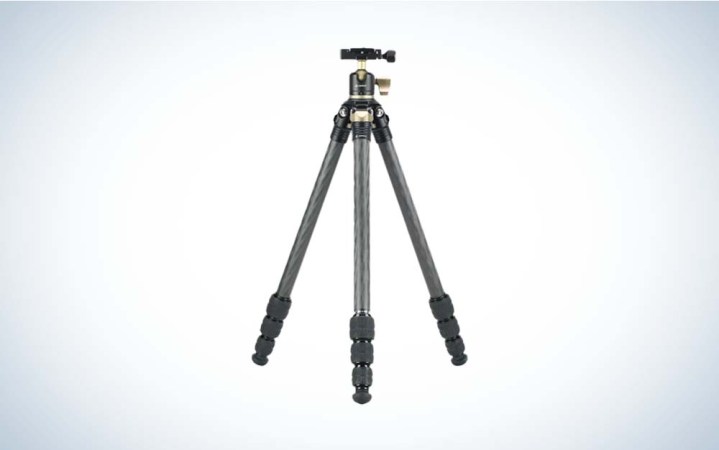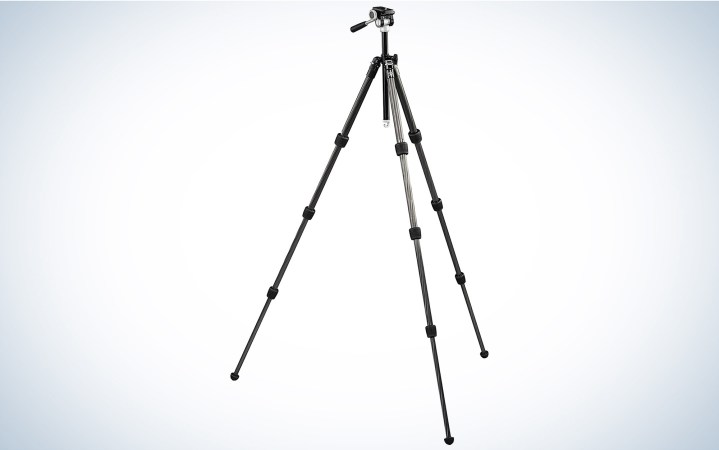We may earn revenue from the products available on this page and participate in affiliate programs. Learn More ›
Stabilizing a spotting scope makes every hunter more effective, but it’s especially useful in the backcountry, where good optics anchored to a hunting tripod can save you many miles of hiking and many torturous feet of steep terrain. Tripods can also elevate your shooting skills. By providing a tall, extremely stable, and more adaptable alternative to a rifle-mounted bipod, a tripod allows shooters to stand, pan, and pivot in order to engage targets at a variety of elevations, distances, and directions.
All these tasks are possible with traditional aluminum tripods, but they are relatively heavy, clunky, and often loud. Carbon fiber has been a lighter, more compact, and vibration-dampening alternative for years, but it’s also very expensive. That’s changing, as manufacturing techniques are lowering the cost of carbon and making the material stronger, lighter, and stiffer. Carbon tripods remain an investment, which is why it’s important to know what to expect from the best hunting tripods before buying them.
- Best for Ultralight Hunting: Vortex Summit Carbon II
- Best Value: Meopta Carbon Tripod
- Best for Travel: Vanguard VEO3 GO
- Best for Big-Game Hunting: Leupold Pro Guide CF-436
- Best for Competition Rifle Shooting: Athlon Midas CF40
- Best for Nature Viewing: Vortex Ridgeview Carbon
- Best for Mobile Shooters: Athlon Midas CF29
- Best for Stand/Blind Hunting: BOG DeathGrip Carbon
- Best for Hog Hunting: Kopfjager K800 with Reaper Grip
- Best for Precision Shooting: Leupold Mark 5 CF-455
- Best for Sheep Hunting: Leupold Alpine CF-425
- Vortex High Country II
How I Tested the Best Hunting Tripods
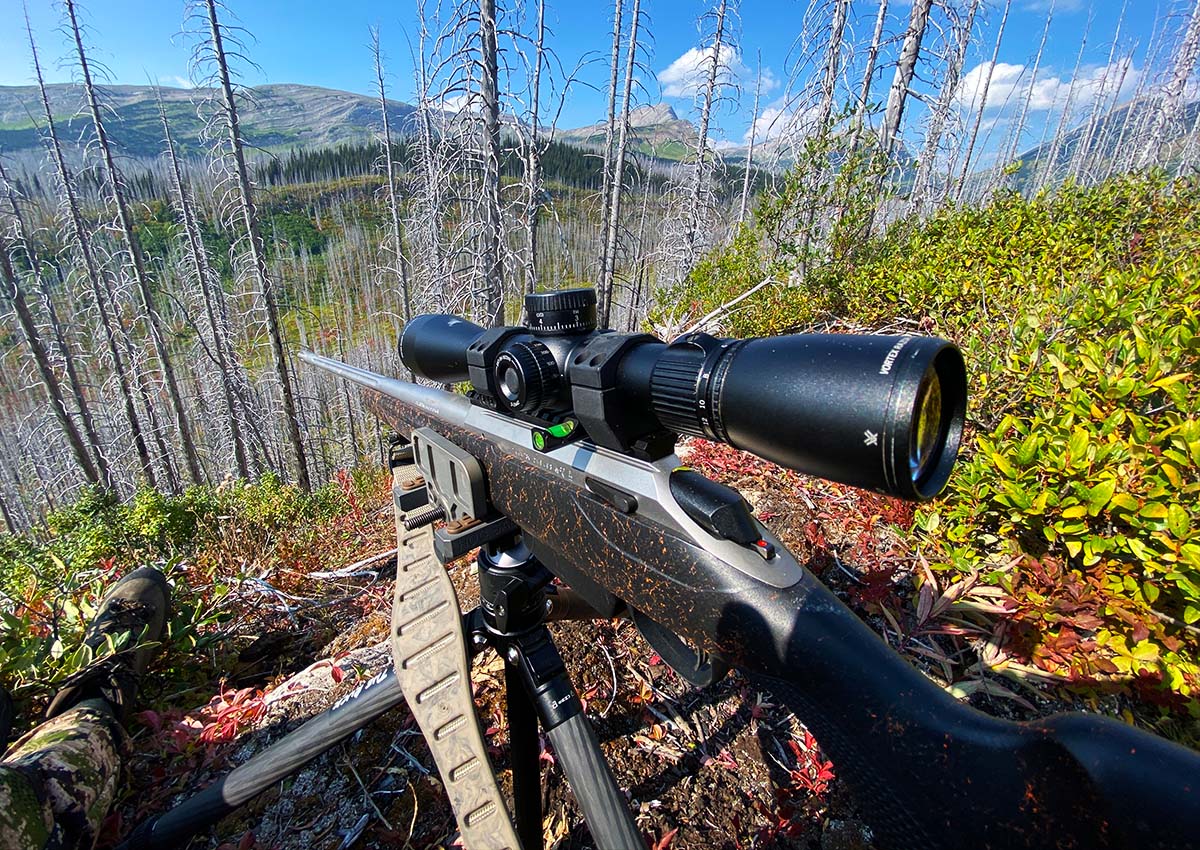
I considered a variety of carbon fiber tripods for this buyer’s guide. Some are intended as rifle supports, others as extremely lightweight options for backpacking hunters who want to stabilize a compact spotting scope or powerful binocular. And a third group splits the middle, bringing enough heft to support full-sized spotting scopes and most rifles while weighing under four pounds, about the limit for packability.
I put each model in this roundup through the same basic regimen. First, I weighed and measured them to confirm (or sometimes correct) manufacturers’ claims. Then I extended them to their maximum length and mounted a series of optics and rifle accessories, depending on their utility. For the smaller tripods, I used a 50mm spotting scope and bracket to support a 15×56 binocular. For the larger tripods, I mounted a big 85mm scope. And for the shooting supports, I mounted and then shot an 11-pound chassis rifle, determining how nimble, smooth, and strong each tripod felt while I was behind the rifle.
Lastly, I measured leg diameter. That’s an important consideration as the beefier the legs, the more stable the tripod, but also the more it weighs. And I assessed the price/value of each of these and examined their warranties. That last consideration is important in order to protect your significant investment.
Best Hunting Tripods: Reviews & Recommendations
Best for Ultralight Hunting: Vortex Summit Carbon II
Key Features
- Weight: 2.5 pounds
- Load Capacity: 22 pounds
- Maximum Leg Diameter: 22mm
- Pan head with Arca-Swiss plate
Pros
- Extremely lightweight
- Quarter-turn locks deploy quickly
- Two-way pan head is simple and fast
- Three-position legs enable a wide variety of set-ups
- Vortex VIP Warranty
Cons
- Twist-lock mechanism is fussy
- Difficult to stabilize
- Undersized for 80mm spotter
The light weight (2.5 pounds) and handy pack length (18 inches) make this an essential companion for backcountry hunters who intend to scout behind their optics. From stabilizing a compact spotting scope or binoculars to using it as a shooting platform, the Carbon Summit II bats way beyond its weight and stature.
The smallest and lightest of Vortex’s fairly new line of carbon-fiber tripods, the Carbon Summit II is configured for backpacks and backcountry hunters. The 2.5-pound tripod tucks into an 18-inch sleeve, but the 4-section legs telescope to 53 inches, not quite tall enough to stand behind but plenty of reach for stabilizing on steep slopes. The business end is a 2-way pan head that’s manipulated by a twist-lock arm that moves with silky precision and accepts Arca-Swiss compatible accessories. It’s a fragile and expensive unit that requires careful deployment, but it’s the ultimate backcountry optics accessory.
Best Value: Meopta Carbon Tripod
Key Features
- Weight: four pounds
- Load Capacity: 30 pounds
- Maximum Leg Diameter: 40mm
- Ball and fluid panning heads
Pros
- Accessible price
- Wide variety of attachments
- Blue accents provide distinctive look
- Extends to 70 inches
Cons
- Carbon fiber legs are rough
- Head loosens over time
- Could use a sexier name
With a dizzying number of accessories and amenities, this workaday carbon tripod can morph from supporting a spotting scope to accommodating a smartphone to accepting almost any aftermarket shooting saddle. While it doesn’t do any single task particularly well, it has more versatility than any tripod on the market. And priced at about $300, it’s a good value considering its peers cost about $100 more.
A full-sized and full-service carbon fiber tripod for under $400, the Meopta unit is more than just a 3-section, twist-lock enabled tripod. It’s a whole kit, shipping with a ball and fluid panning head, two different plates, a smartphone bracket, and screw-in spike feet for those times you need to anchor the legs into gravel or sod. Weighing just four pounds, it can handle full-sized spotters and most rifles, it extends to 70 inches, and its 3-position legs can splay out to stabilize loads in high winds.
Best for Travel: Vanguard VEO3 GO
Key Features
- Weight: 2.3 pounds
- Load Capacity: 8.8 pounds
- Maximum Leg Diameter: 22mm
- Bluetooth-enabled remote
Pros
- Huge extension range
- Lightweight
- Configured for smartphone use
- Accessibly priced
Cons
- Can’t stabilize full-sized spotting scopes
- Thin lower leg sections are fragile
A super-compact travel tripod, the Vanguard VEO3 packs a ton of versatility into its small stature. Its 5-section legs and 2-section carbon center post adjust with twist-lock controls, extending from 13 to 53 inches. One of the legs converts to a monopod or selfie stick. The ball-head is nimble and fairly tight, and smartphone users will like the Bluetooth-enabled remote that allows for hands-free camera use.
While this can’t be considered a full-sized tripod, largely because its load capacity is limited to under 10 pounds, this super-convertible unit does just about everything short of supporting a big optic. It extends from a very compact 13 inches up to 53. Its T-50 ball head is fully compatible with Arca-Swiss components and one leg can be removed and converted to a monopod or selfie stick. It’s a strong choice for sticking in a backpack or even a duffle bag for travel, and at just over $200, it’s priced attractively for a fully carbon tripod.
Best for Big-Game Hunting: Leupold Pro Guide CF-436
Key Features
- Weight: 4 pounds
- Load Capacity: 40 pounds
- Maximum Leg Diameter: 32mm
- 4-section legs
Pros
- Robust leg diameters
- High-quality carbon material
- Very high weight-to-load ratio
- Folds to 18 inches
Cons
- Separate center post is easily lost
- Pricey
Call this a Goldilocks tripod, sized between the super compact and the beefy shooting platforms. The CF-426 is capable of stabilizing a full-sized spotting scope or just about any shooting saddle, and its 67-inch maximum height makes it a good choice for any stand-up activities.
A mid-size and weight, fully carbon tripod, the CF-436 fits in the middle of Leupold’s line of excellent carbon hunting tripods. The Alpine is one of the best hunting tripods sized for backcountry hunters, while the Mark V is sized and configured for shooters. The Pro Guide is light and packable enough for just about any walk-about hunting while still strong enough to support the best spotting scopes or rifle. I took this tripod, fitted with the Spartan Javelin Davros head, to the Yukon for a horseback moose hunt, where I shot a bull because I was able to stabilize my rifle high above the brush. Weighing four pounds, with a 40-pound load capacity, this has one of the best weight-to-capacity ratios in the field.
Best for Competition Rifle Shooting: Athlon Midas CF40
Key Features
- Weight: 8.4 pounds
- Load Capacity: 88 pounds
- Maximum Leg Diameter: 40mm
- Ships with two heads, tripod hammock
Pros
- Arca compatibility for direct-to-rifle attachment
- Includes hammock to add stabilizing weight
- Capable of supporting 88 pounds
- Molle leg protectors look tacti-cool
Cons
- Expensive
- Big (29 inches folded) and heavy (8.4 pounds)
This is a serious (and seriously expensive) piece of shooting kit, but it’s packed with value: two different heads to accommodate either rifles or optics, the beefiest carbon legs in our field, and high-quality components.
The Midas, which is the largest and strongest of Athlon’s line of carbon tripods (or any other in this roundup), ships as a complete kit, with both a ball and leveling head, shoulder strap, hammock for adding rocks and other weight to the legs, and a cup mount with tension control for shooters. Its 10-layer carbon legs are among the smoothest and strongest in the field, and the twist-lock controls and aluminum hardware are smooth and strong. If you’re a competition shooter looking to get off the ground and get right into the long-range game, this is a great choice because you don’t have to ala mode the components; they’re all included.
Best for Nature Viewing: Vortex Ridgeview Carbon
Key Features
- Weight: three pounds
- Load Capacity: 22 pounds
- Maximum Leg Diameter: 26mm
- Smooth and strong 2-way pan head
Pros
- Extends to 73.8 inches
- Twist-lock leg controls deploy quickly
- Tension control on panning head is easy to use
- Light enough for a backcountry option
Cons
- Unstable at highest extension
- Not for use with heavy rifles
A highly versatile size and weight, the Ridgeview occupies the middle ground of Vortex’s line of carbon tripods but leans more toward backcountry hunting than front-country shooting support. The Ridgeview is strong enough to support a full-size spotter, unusual in this class.
The most versatile tripod in this field, the mid-sized Ridgeview Carbon is stout enough to support most optics, and it’s extremely packable. It would make a very good travel or birdwatching unit, quick to deploy, useful for cameras or a wide variety of optics. The mid-weight carbon legs do a nice job of dampening most vibrations, but users will want to invest in a hammock or center-post weight to add even more dampening to the unit in windy conditions. And the Arca-Swiss-compatible plate mates up with most mounting systems.
Best for Mobile Shooters: Athlon Midas CF29
Key Features
- Weight: 5.5 pounds
- Load Capacity: 33 pounds
- Maximum Leg Diameter: 29mm
- Ships with two heads, hammock
Pros
- Kit contains all necessary amenities
- Fits inside custom zippered case
- Carbon fiber is smooth and strong
- Aluminum furniture is well machined
Cons
- Pricey
- Needs additional weight to stabilize in windy conditions
Little brother to Athlon’s Midas CF40, the 29mm is sized for walk-about shooters and hunters. It’s still a good-sized package—5.5 pounds and 26-inch pack length—but with a 33-pound load capacity, it’s light enough for all-day packing but stout enough to stabilize even big chassis rifles and precision scopes.
The rise in long-range target shooting and competitions has spurred the development of accessories, and none is more important than a stout, adjustable tripod to put your bullets downrange. This is a great choice, with both a bowl head that accommodates a tension-grip rifle saddle and a ball head with Swiss-Arca plate that can support just about any optic, including super-sized spotters and the best binoculars for hunting. The Midas 29 ships with a leg hammock that can be filled with weight in order to add more stability, and the 29mm carbon legs deploy with smooth, strong authority. It’s a great option for mobile shooters or hunters.
Best for Stand/Blind Hunting: BOG DeathGrip Carbon
Key Features
- Weight: 7.5 pounds
- Load Capacity: 30 pounds
- Maximum Leg Diameter: 40mm
- DeathGrip shooting saddle
Pros
- Accessible price
- DeathGrip saddle is stable but won’t mar gun
- Legs lock in three different positions (20, 45, and 85 degrees)
- Bubble helps to level head
- Tension control is easy to use
Cons
- Push-button leg locks are easy to bump
- Hard to swap heads
Optimized for hunters who shoot from tree stand platforms or ground blinds, this tripod and associated shooting saddle is infinitely adjustable and can accommodate just about any gun or crossbow. Because it will hold a gun at the ready, the DeathGrip is a smart choice to use with beginning hunters, whose arms frequently tire from holding a gun, and whose nerves sometime pull their gun off target. With this simple support, a gun or crossbow can be held in position with minimum fuss or noise. Also available in an aluminum-leg model, the DeathGrip Carbon is light enough to pack and the carbon legs minimize flex and vibration, providing a very stable platform.
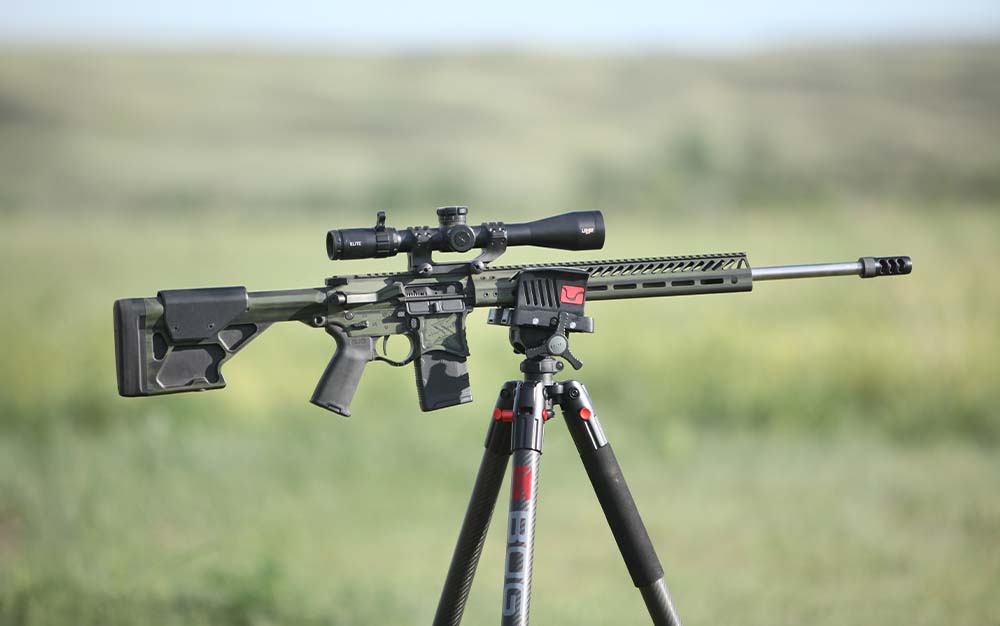
Best for Hog Hunting: Kopfjager K800 with Reaper Grip
Key Features
- Weight: 3.5 pounds
- Load Capacity: 20 pounds
- Maximum Leg Diameter: 40mm
- Extends to 65 inches, packs to 19 inches
Pros
- Snap-lock legs easy to deploy
- Base tripod accepts most standard heads
- Grip provides 360-degree panning and 109 degrees of tilt
Cons
- Snap locks can get fouled with mud and grit
- Carbon legs are slick when wet
A favorite of Texas hog hunters, this is a hard-wearing, extremely versatile platform for rifles of all types deployed in all kinds of field conditions. Combined with the Reaper head, the tripod is stable enough to enable the variable shooting conditions encountered in high-volume hog hunts.
A workhorse of a tripod that you’ll find in a lot of hog-hunter’s pickups, the Kopfjager is also available in an aluminum model (K700). I like the carbon for its light weight but also for its vibration-dampening talents, an important consideration when you’re making long shots through thermal optics at nighttime hogs. The Reaper grip, which you can buy separately if you want, accommodates a wide range of the best rifles, from chassis guns to ARs. And when you don’t want to support a rifle, the tripod is compatible with most ball-mount heads with 3/8-16-inch threads.
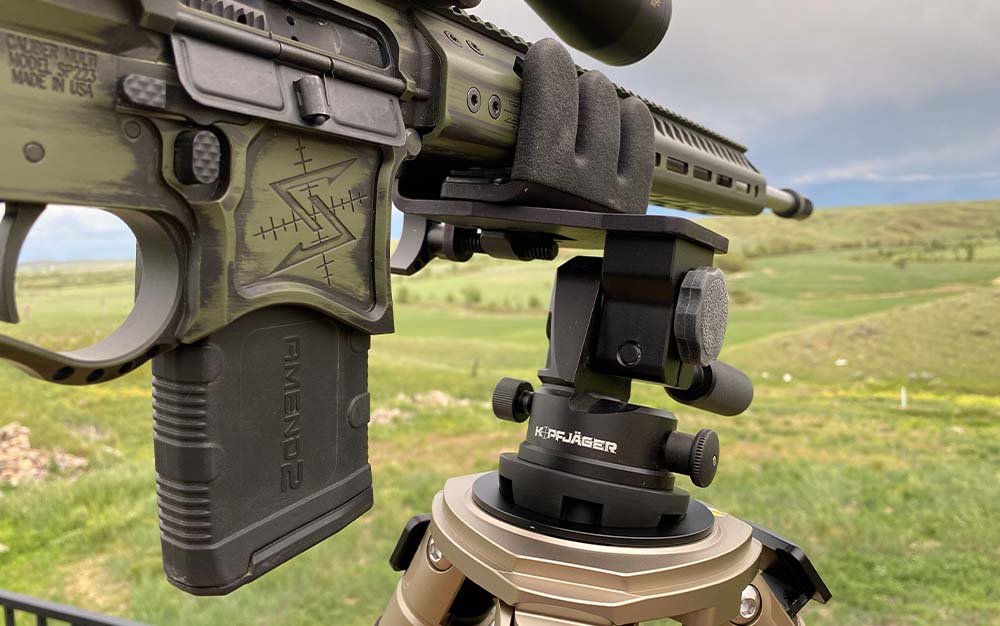
Best for Precision Shooting: Leupold Mark 5 CF-455
Key Features
- Weight: 7.3 pounds
- Load Capacity: 55 pounds
- Maximum Leg Diameter: 40mm
- Extremely smooth ball head
Pros
- Extremely high weight-to-load ratio
- Twist-lock legs are stout and smooth
- Precision-machined hardware
- Safety-lock head release is strong and easy to use
Cons
- At over $1,000, it’s pricey
- Users must buy aftermarket accessories
The pinnacle of Leupold’s carbon fiber tripod line, this is a rock-solid shooting platform and almost infinitely versatile with Leupold’s aftermarket accessories, which include shooting saddle, binocular field clamp, and binocular tripod adapter. The 10-layer carbon fiber legs are elegant and strong. This investment-grade tripod handles just about any shooting or glassing task asked of it. The CF-455 fits nicely in Leupold’s Mark 5 product line, offering best-in-class durability and performance. It’s useful to know it also sits atop Leupold’s relatively new carbon tripod line, offering more of everything—leg diameter, weight capacity, extension, and versatility—than the Alpine and Pro Guide tripods. Plus, it’s lovely to look at and doesn’t scream tactical as many of its peers on the firing line do.
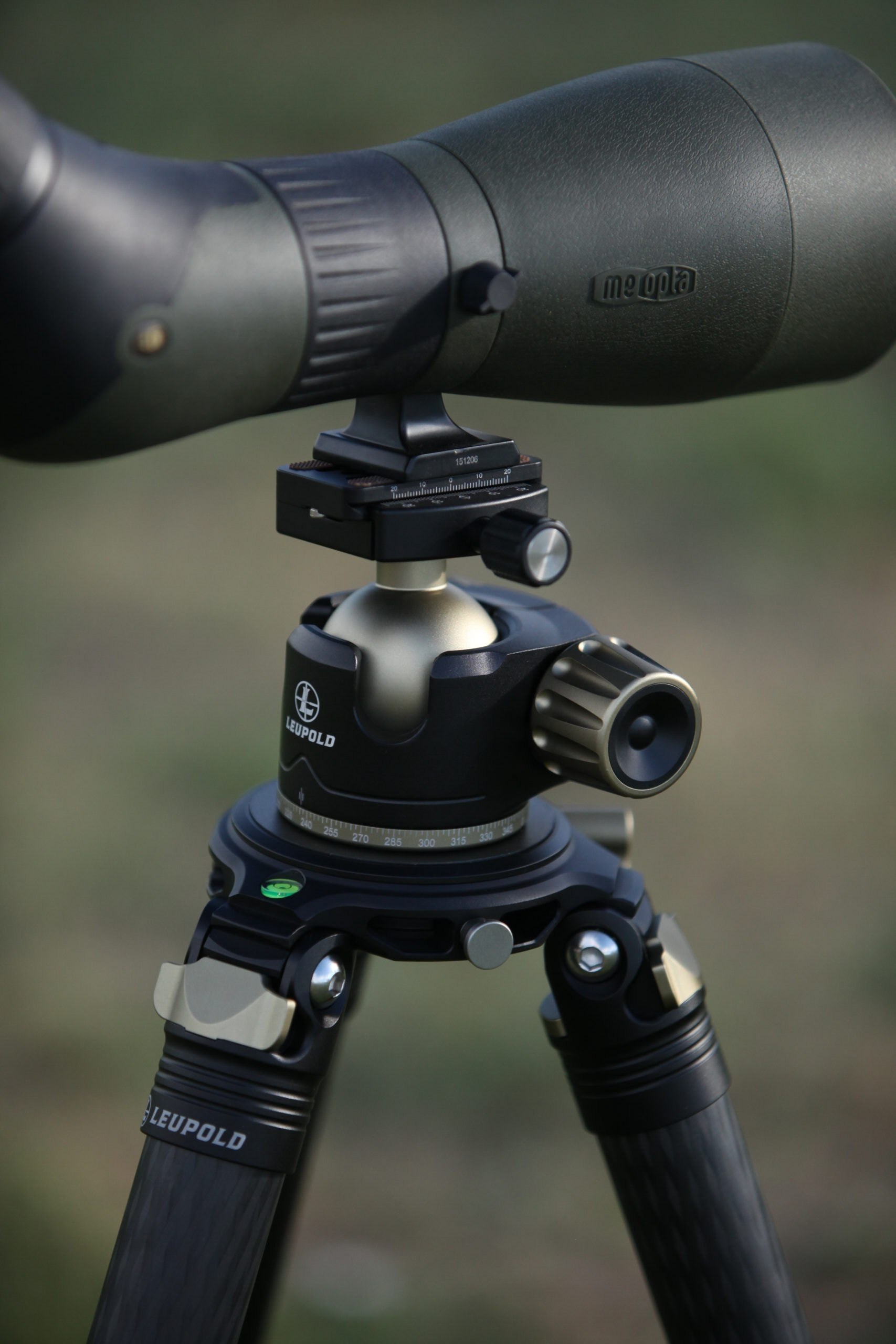
Best for Sheep Hunting: Leupold Alpine CF-425
Key Features
- Weight: two pounds
- Load Capacity: 13 pounds
- Maximum Leg Diameter: 22mm
- Two-way panning head with Arca-Swiss compatibility
Pros
- Classy and strong grade of carbon fiber
- Twist-lock leg hardware deploys quickly
- Head pairs with wide range of optics adapters
- Extremely light and packable
Cons
- Tiny mounting plate is easy to lose
- Removable center post is also easy to lose
- Too small for full-size spotters
Weighing just two pounds and packing down to 18 inches, this tripod fits in just about any pack or backcountry hunt. It’s surprisingly strong and durable for its fine bones. One of a class of ultralight tripods (Vortex’s Summit Carbon II and Vanguard’s VEO3 are the others in this roundup), the Alpine’s name says it all. This is an optics-ready platform for binoculars or mid-sized and compact spotting scopes that’s at its best when ounces count. It’s a handy shooting platform when paired with aftermarket accessories such as Spartan’s Davros head and rifle socket. The carbon legs do a nice job of dampening vibrations, and the head pans and tilts smoothly.
Vortex High Country II
Vortex High Country II
Key Features
- Weight: 4.0 pounds
- Min Height: 11.3 inches
- Max Load: 22 pounds
- Max Height: 62.5 inches
- Leg Sections: 3
- Leg Angles: 3
- Leg Locks: Flip Lever
- Leg Material: Aluminum
- Folded Dimensions (HxW): 24.3 x 4.0 inches
Pros
- Smooth pan head
- Great for spotting scopes, binoculars, light rifles, and photography
- Folds up small
Cons
- Legs flex with load
The tripod world is currently dominated by light and expensive carbon models. While there’s no doubt carbon tripods are superior, there’s still a place for more affordable aluminum versions. For example the High Country II Kit costs $200 and you can get the similarly sized Vortex Summit II carbon tripod for $400. So we’re talking about half the price for an aluminum tripod.
What you get is a tripod that can deploy from about a foot off the ground to 5 feet off the ground. With that range it can hold a spotter while you shoot prone up to glassing while standing. The High Country II is fit for packing in on a hunt, as long as you are OK with it weighing a little (about 1.5 pounds more than the carbon version). This tripod isn’t the best option for use as a shooting rest. At the 2023 Outdoor Life gun test we shot off the High Country II and a much stiffer carbon tripod. We saw more scope movement on the High Country II, and even just pressing down on the tripod you can see the legs flex. If you are looking for a tripod to make precise shots at long ranges, there are much better options for that purpose.
However, if you need a tripod that won’t break the bank and pans smoothly while glassing, then the High Country II is definitely worth consideration.
How to Choose the Best Hunting Tripod
Buying a carbon fiber tripod isn’t a frivolous task. The most expensive cost over $1,000, and even entry-level units will set you back nearly $300. Your first task is to think through how you’ll use it. If you’re a backcountry hunter looking for a lightweight and packable tripod that will stabilize a mid-sized spotting scope or binoculars, look for units in the 2- to 3-pound range that pack to about 18 inches. If you want a tripod as a shooting platform, you’ll want a model with a bowl mount that will accept a shooting saddle or some other rifle holder.
No matter the purpose, look for tripods with high-grade hardware. That includes tight leg locks—whether twist or flip locks—and head/plate furniture. Test the heads for fluid panning and angle control. And lastly, consider compatibility with a wide range of optics and accessories. The best have either Arca-Swiss heads or those with 1/4-20 thread pitch.
Read Next: The Best Shooting Bags of 2023
FAQs
Fundamentally, you should look for stability in a hunting tripod. After all, that’s its great promise for hunters, to stabilize either an optic or a gun, depending on what you want to use it for. Secondly, look for adaptability. For some tripods, that may mean reach, or the ability to extend in length from the minimal pack size all the way up to a height that you can easily stand behind. For others, it may mean widening the legs to create a wind-resistant base. And for others, it’s the ability to accept a wide variety of heads and mounts, from cameras to spotting scopes to gun saddles.
Many tripods will switch-hit between supporting a spotting scope or supporting a rifle. It all depends on both the strength of the legs and the amount of weight they’re able to support, as well as the type of heads they’ll accept. Nearly all tripods either come with or will accept what’s called a ball head. These have a central ball held in a socket that can be moved in nearly all directions and then tightened down to make a rock-solid support. But make sure that the head has a mount with a standard plate, which has a 1/4×20 thread. That’s the standard thread that mates up with most spotting scopes and many gun saddles. Some tripods, like the BOG DeathGrip in our test, are purpose-built for guns and crossbows. Others, like most of the Vortex and Leupold tripods, will accept either spotting scopes or aftermarket gun grips.
Tripods built for use with spotting scopes will accept just about any sort of optic, from full-sized spotting scopes to compact units and even mounting systems for binoculars. There are two things to look for. The first is that the mounting plate has a threaded connector with 1/4×20 thread size. That’s the standard for all cameras and nearly all spotting scopes. However, some super-sized spotters use a beefier adapter with 3/8×16 thread size. Often the larger thread is screwed over the top of the smaller thread, so you get both in a single stud. Many tripods have a quick-release (QR) plate on their heads. These heads can be attached to one or more attachments to make trading between them fast and simple. It’s a good idea to buy a couple of aftermarket QR plates and pre-mount them on your optics so that you can quickly switch the one to mount on your tripod.
Final Thoughts
While there are plenty of aluminum tripods on the market, the trend is decidedly toward carbon fiber. It makes sense, as it’s easier to produce all the time and manufacturers have figured out that it makes a very capable material for the best hunting tripods. With good care and making sure not to overload them, carbon fiber provides a strong, versatile, and lightweight platform for a wide variety of glassing and shooting tasks.
- Best for Ultralight Hunting: Vortex Summit Carbon II
- Best Value: Meopta Carbon Tripod
- Best for Travel: Vanguard VEO3 GO
- Best for Big-Game Hunting: Leupold Pro Guide CF-436
- Best for Competition Rifle Shooting: Athlon Midas CF40
- Best for Nature Viewing: Vortex Ridgeview Carbon
- Best for Mobile Shooters: Athlon Midas CF29
- Best for Stand/Blind Hunting: BOG DeathGrip Carbon
- Best for Hog Hunting: Kopfjager K800 with Reaper Grip
- Best for Precision Shooting: Leupold Mark 5 CF-455
- Best for Sheep Hunting: Leupold Alpine CF-425
- Vortex High Country II
